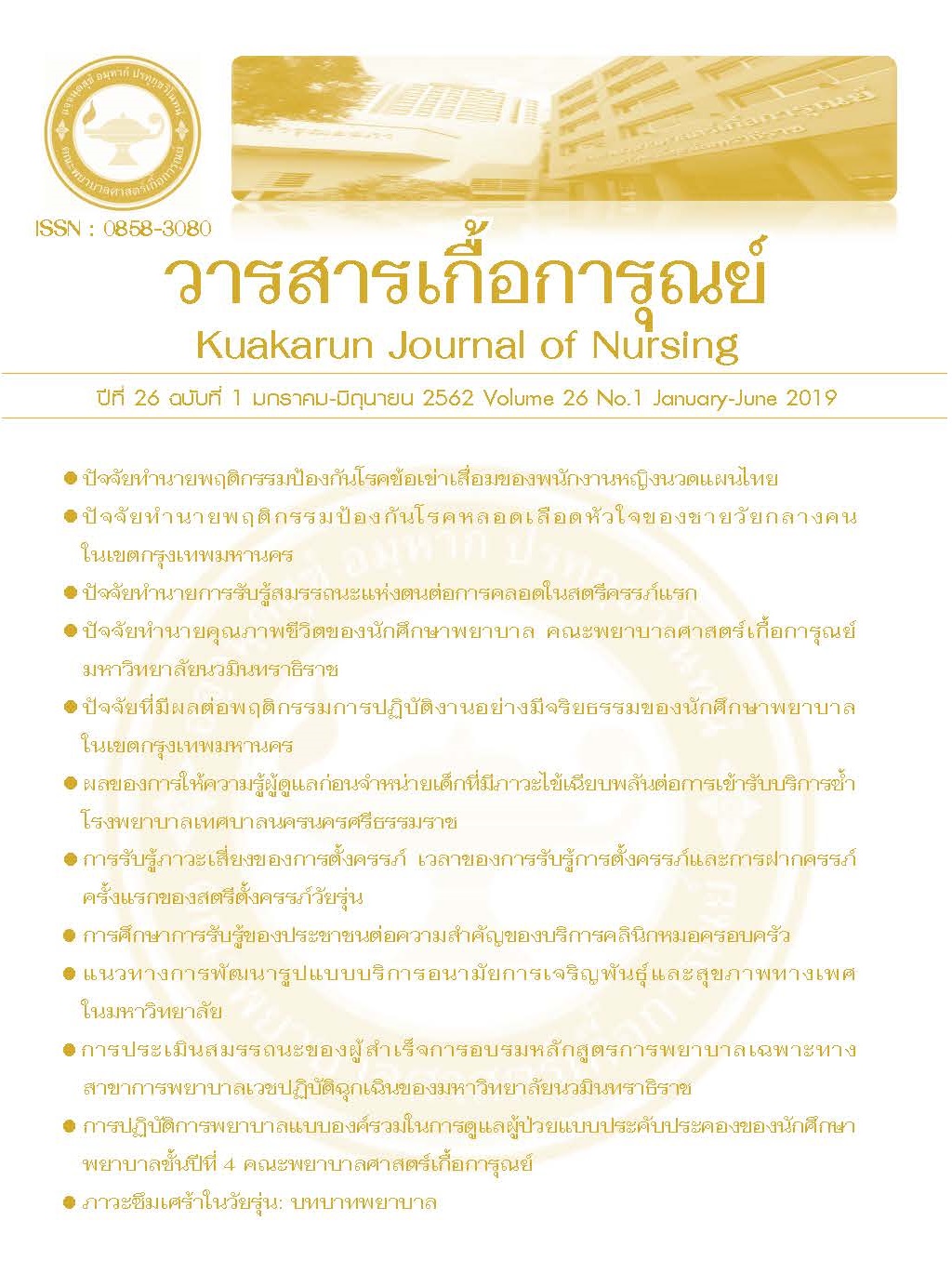การรับรู้ภาวะเสี่ยงของการตั้งครรภ์ เวลาของการรับรู้การตั้งครรภ์ และการฝากครรภ์ครั้งแรกของสตรีตั้งครรภ์วัยรุ่น
คำสำคัญ:
การฝากครรภ์ครั้งแรก, สตรีตั้งครรภ์วัยรุ่นบทคัดย่อ
การฝากครรภ์ครั้งแรกของสตรีตั้งครรภ์วัยรุ่นมีความสำคัญต่อการลดภาวะแทรกซ้อน ทั้งต่อสตรีตั้งครรภ์และทารกในครรภ์ การศึกษานี้เป็นวิจัยเชิงพรรณนาหาความสัมพันธ์ (descriptive correlational research) เพื่อศึกษาการรับรู้ภาวะเสี่ยงของการตั้งครรภ์
เวลาของการรับรู้การตั้งครรภ์และการฝากครรภ์ครั้งแรกของสตรีตั้งครรภ์วัยรุ่น กลุ่มตัวอย่าง คือ สตรีตั้งครรภ์วัยรุ่นที่มีอายุระหว่าง 10-19 ปี ที่มารับบริการฝากครรภ์ครั้งแรก ณ โรงพยาบาล ชลบุรี โรงพยาบาลบางละมุง และโรงพยาบาลแหลมฉบัง จังหวัดชลบุรี จำนวน 123 ราย เครื่องมือที่ใช้วิจัยมีทั้งหมด 3 ชุด ประกอบด้วย แบบบันทึกข้อมูลส่วนบุคคล แบบสอบถามการ รับรู้ภาวะเสี่ยงของการตั้งครรภ์ของเฮียแมนและกัฟตัน และแบบสอบถามเวลาของการรับรู้การตั้งครรภ์ ผู้วิจัยดัดแปลงจากข้อคำถาม 1 ข้อในแบบสอบถามการประเมินติดตามภาวะเสี่ยงของการตั้งครรภ์ (The Pregnancy Risk Assessment Monitoring System [PRAMS]) ของกิลเบิร์ท และคณะ คำนวณหาความเชื่อมั่นของแบบสอบถามการรับรู้ภาวะเสี่ยงของการตั้งครรภ์โดยใช้สัมประสิทธิ์อัลฟาครอนบาค ได้เท่ากับ .86 วิเคราะห์ข้อมูลโดยใช้สถิติพรรณนา และสัมประสิทธิ์สหสัมพันธ์สเปียร์แมน
ผลการวิจัยพบว่า (1) การรับรู้ภาวะเสี่ยงของการตั้งครรภ์อยู่ในระดับต่ำโดย มีคะแนนเฉลี่ย 162.77 (S.D = 164.06) (2) เวลาของการรับรู้การตั้งครรภ์เฉลี่ย 7.97 สัปดาห์ (S.D = 5.75) (3) การฝากครรภ์ครั้งแรกมีอายุครรภ์เฉลี่ย 16.55 สัปดาห์ (S.D = 7.78) (4) เวลาของการรับรู้การตั้งครรภ์มีความสัมพันธ์กับการฝากครรภ์ครั้งแรกของสตรีตั้งครรภ์วัยรุ่นทางบวกระดับปานกลางอย่างมีนัยสำคัญทางสถิติ (r = .345, p< .01) แต่การรับรู้ภาวะเสี่ยงของการตั้งครรภ์ไม่มีความสัมพันธ์กับการฝากครรภ์ครั้งแรกของสตรีตั้งครรภ์วัยรุ่น ผลการวิจัยครั้งนี้ สามารถนำมาเป็นข้อมูลพื้นฐานสำหรับการส่งเสริมให้สตรีตั้งครรภ์วัยรุ่นฝากครรภ์ครั้งแรกก่อนอายุครรภ์ 12 สัปดาห์ โดยคำนึงถึงเวลาของการรับรู้การตั้งครรภ์
เอกสารอ้างอิง
เจริญพันธุ์ ในวัยรุ่นและเยาวชน ปี 2558. สืบค้นจาก https://rh.anamai.moph.go.th/ewt_dl_link.php?nid=86
กระทรวงสาธารณสุข. (2560ก). ตัวชี้วัดกระทรวงสาธารณสุข:ร้อยละหญิงตั้งครรภ์ได้รับการฝากครรภ์
ครั้งแรกก่อนหรือเท่ากับ 12 สัปดาห์ ปีงบประมาณ 2559. สืบค้นจาก
https://hdcservice.moph.go.th/hdc/main/index.
กระทรวงสาธารณสุข. (2560ข). ตัวชี้วัดสาธารณสุข จังหวัดชลบุรี. สืบค้นจาก
cbi.hdc.moph.go.th/main/index
กระทรวงสาธารณสุข. (2559). แนวทางการตรวจสุขภาพที่จำเป็นเหมาะสมสำหรับหญิงมีครรภ์.
นนทบุรี: สำนักงานกิจการโรงพิมพ์องค์การสงเคราะห์ทหารผ่านศึก.
จันทรรัตน์ เจริญสันติ, (2557). การวินิจฉัยการตั้งครรภ์ การคาดคะเนอายุครรภ์ และกำหนดวันคลอด.
ในอำไพ จารุวัชรพาณิชกุล. (บรรณาธิการ), สาระหลักทางการพยาบาลมารดาทารกแรกเกิด
และการผดุงครรภ์. เชียงใหม่: ครองช่างพริ้นท์ติ้ง
เดือนเพ็ญ ศิลปอนันต์, (2557). ทำไมจึงมาฝากครรภ์: ทัศนะของสตรีตั้งครรภ์โรงพยาบาลบางกรวย จังหวัดนนทบุรี. วารสารสมาคมเวชศาสตร์ป้องกันแห่งประเทศไทย, 4(2), 126-134.
นฤนาท จอมภาปิน. (2558). สถานการณ์การตั้งครรภ์วัยรุ่น :ศึกษาเฉพาะกรณีหญิงที่ฝากครรภ์หรือคลอดในโรงพยาบาลเถิน จังหวัดลำปาง. วารสารการส่งเสริมสุขภาพและอนามัยสิ่งแวดล้อมล้านนา, 5(2), 30-37.
นภศพร ชัยมาโย, จันทรรัตน์ เจริญสันติ, และพรรณพิไล ศรีอาภรณ์. (2559). ปัจจัยที่เกี่ยวข้องกับการ
ฝากครรภ์ของสตรีตั้งครรภ์วัยรุ่น. วารสารการพยาบาลและการดูแลสุขภาพ, 34(4), 106-114.
บุญลาภ ทิพย์จันทร์ และวันเพ็ญ แก้วปาน. (2555). ปัจจัยที่มีความสัมพันธ์กับพฤติกรรมการดูแลตนเองของหญิงตั้งครรภ์วัยรุ่น ในจังหวัดเพชรบุรี. วาสารสำนักงานป้องกันควบคุมโรค 7, 11(1), 41-60.
ปัญญา สนั่นพานิชกุล และยศพล เหลืองโสมนภา. (2558). การตั้งครรภ์ในหญิงวัยรุ่น: ปัจจัยทางด้านมารดาที่มีผลต่อทารก. วารสารศูนย์การศึกษาแพทยศาสตร์คลินิก โรงพยาบาลพระปกเกล้า, 32(2), 147-156.
พิทักษ์พงษ์ พรรณพราว. (2558). การจัดการเชิงรุกในการใช้บัตรสุขภาพแม่และเด็กของการฝากครรภ์ครั้งแรก(ที่มีอายุครรภ์น้อยกว่าหรือเท่ากับ 12 สัปดาห์)ในโรงพยาบาลนาดูน อำเภอนาดูน จังหวัดมหาสารคาม. วารสารโรงพยาบาลมหาสารคาม, 12(1), 77-86.
มะลิวรรณ หมื่นแกล้วกล้าวิชิต. (2551). ความสัมพันธ์ระหว่างการรับรู้ภาวะสุขภาพแรงสนับสนุนทางสังคมเจตคติต่อการตั้งครรภ์และการฝากครรภ์ของสตรีตั้งครรภ์วัยรุ่น(วิทยานิพนธ์พยาบาลศาสตร์มหาบัณฑิต สาขาวิชาการพยาบาลมารดาและทารก). บัณฑิตวิทยาลัย, มหาวิทยาลัยมหิดล. นครปฐม.
วารณี เวชพันธ์. (2558). ปัจจัยที่มีผลต่อการฝากครรภ์ครั้งแรกในพื้นที่ตำบลกะรน อำเภอเมือง จังหวัดภูเก็ต มหาวิทยาลัยสงขลานครินทร์. วารสารสุขภาพภาคประชาชนภาคใต้, 29(2), 33-37.
ศศิธร อินทุดุม, มะลิ คมแหลม, และจารุณี เสนาะธรรม. (2557). เหตุผลของการมาฝากครรภ์ช้าโรงพยาบาลแพร่. วารสารโรงพยาบาลแพร่, 22(2), 20-26.
สิทธิชน สุริยะวงศ์กุล, วิศรุต มานะศิริสุข, ภัทรอนงค์ นฤทุกข์, และพลอยพิณ เลิศจิตบรรจง. (2556). การศึกษาเพื่อพัฒนาการมา early ANC ของโรงพยาบาลโชคชัย. สืบค้นจาก https://med.mahidol.ac.th/commed/sites/default/files/public
อัญชลี จิตราภิรมย์, จันทรรัตน์ เจริญสันติ, และพรรณพิไล ศรีอาภรณ์. (2557). การรับรู้ภาวะเสี่ยงของการตั้งครรภ์ ความรู้สึกไม่แน่นอน และความเครียดของสตรีที่เป็นเบาหวานขณะตั้งครรภ์. พยาบาลสาร, 41(1), 50-61.
Atkinson, S. J., & Farias, M. F. (1995). Perceptions of risk during pregnancy amongst urban women in northeast Brazil. Social Science & Medicine, 41(11), 1577-1586.
doi:10.1016/0277-9536(95)00021-X
Ayoola, A. B. (2007). Timing of Pregnancy Recognition as a Predictor of Prenatal Care Initiation and Birth Outcomes. (Doctoral dissertation). Available from ProQuest Dissertation & Theses database. (UMI NO. 3312660)
Ayoola, A. B., Stommel, M., & Nettleman, M. D. (2009). Late recognition of pregnancy as a
predictor of adverse birth outcomes. American Journal of Obstetrics and
Gynecology, 201(2), 156-158. doi: 10.1016/j.ajog.2009.05.011
Ayoola, A. B., Nettleman, M. D., Stommel, M., & Canady, R. B. (2010). Time of pregnancy
recognition and prenatal care use: A population - based study in the United States. Birth, 37(1), 37-43. doi: 10.1111/j.1523-536X.2009.00376.x
Ayoola, A. B., & Zandee, G. L. (2013). Low - Income Women's Recommendations for
Promoting Early Pregnancy Recognition. Journal of Midwifery & Women’s
Health, 58(4), 416-422. doi: 10.1111/jmwh.12078
Ayoola, A. B. (2015). Late Recognition of Unintended Pregnancies. Public Health Nursing, 32(5),
462-470. doi: 10.1111/phn.12182
Ayoola, A. B., Zandee, G. L., & Adams, Y. J. (2016). Women's Knowledge of Ovulation, the Menstrual Cycle, and Its Associated Reproductive Changes. Birth, 43(3), 255–262. doi:
10.1111/birt.12237
Becker, M. H. (1974). The health belief model and sick role behavior. Health Education & Behavior, 2(4), 409-419. Retrived from https://heb.sagepub.com/content/2/4/409.extract
Chames, M. C., Bailey, J. M., Greenberg, G. M., Harrison, R. V., & Schiller, J. H. (2015). Prenatal Care Guidelines for Clinical Care Ambulatory. Retrived from https://www.med.umich.edu/1info/FHP/practiceguides/newpnc/PNC.pdf
Cunningham, F. G., Leveno, K. J., Bloom, S. L., Spong, C. Y., Dashe, J. S., Hoffman, B. L., . . . Sheffield, J. S. (2014). Williams Obstetrics (24sted.). New York: McGraw-Hill
Gilbert, B. C., Shulman, H. B., Fischer, L. A., & Rogers, M. M. (1999). The Pregnancy Risk Assessment Monitoring System (PRAMS): Methods and 1996 response rates from 11 states. Maternal and Child Health Journal, 3(4), 199-209. doi: 10.1023/A:1022325421844
Govender, T. (2016). The impact of access to antenatal care on maternal health outcomes amon young adolescents on the North coast of KwaZulu-Natal, South Africa (Doctoral
dissertation). Retrived from. https://ir.dut.ac.za/handle/10321/1520
Gross, K., Alba, S., Glass, T. R., Schellenberg, J. A., & Obrist, B. (2012). Timing of antenatal care for adolescent and adult pregnant women in south-eastern Tanzania. BMC pregnancy and childbirth, 12(1), 1. doi: 10.1186/1471-2393-12-16
Heaman, M. I., & Gupton, A. L. (2009). Psychometric testing of the perception of pregnancy risk questionnaire. Research in nursing & health, 32(5), 493-503. doi: 10.1002/nur.20342
Ivanov, L. L., & Flynn, B. C. (1999). Utilization and satisfaction with prenatal care services. Western Journal of Nursing Research, 21(3), 372-386. doi: 10.1177/01939459922043938
Jones, G. L., Haddrill, R., Mitchell, C., & Anumba, D. A. (2011). Why do women attend late for antenatal booking? A qualitative interview study exploring the perspectives of service users and stakeholders. Journal of Epidemiology and Community Health, 65(Suppl 2), A4. doi: 10.1136/jech.2011.143586.9
Kliegman, R. M., Stonton, B. F., St Geme, J., W., & Schor, N., F. (2016). Nelson textbook of pediatrics, (20th ed.). Philadelphia: Elsevier.
Nicolaides, K. H. (2011). Screening for fetal aneuploidies at 11 to 13 weeks. Prenatal diagnosis, 31(1), 7-15. doi: 10.1002/pd.2637
Polit, D. F., & Beck, C. T. (2017). Nursing research: Generating and assessing evidence for nursing
practice (10thed.). Philadelphia : Wolters Kluwer Health
Taghizadeh, Z., Cheraghi, M. A., Kazemnejad, A., Pooralajal, J., & Aghababaei, S. (2017).
Difference in Perception of Pregnancy Risk in Two Maternal Age Groups. Journal of Clinica
and Diagnostic Research: JCDR, 11(5), 9-12. doi: 10.7860/JCDR/2017/23661.9915
World health Organization. (2016). WHO recommendations on antenatal care for a positive
pregnancy experience. Retrived from
https://apps.who.int/iris/bitstream/10665/250796/1/9789241549912-eng.pdf
World Health Organization. (2016a). Adolescent pregnancy. Retrived from
https://www.who.int/maternal_child_adolescent/topics/maternal/adolescent_pregn ancy/en
World Health Organization[WHO].. (2010). Packages of interventions for family planning, safe
abortion care, maternal, newborn and child health. WHO. Retrived from https://www.clacaidigital.info:8080/xmlui/handle/123456789/307#sthash.yRItvUVs.dpuf















